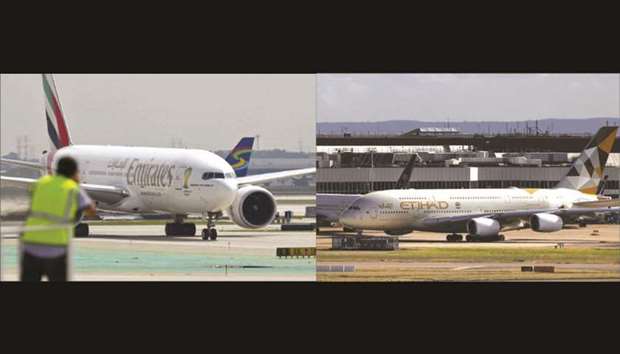The UAE has always tom-tommed aviation as being its most competitive and resilient sector
For many years, the United Arab Emirates has seen aviation as key to its overall future sustainable development, and therefore, invested heavily on infrastructure, constructing international airports and establishing international aviation companies.
According to an estimate, the aviation sector makes a contribution of $80bn to the UAE’s economy, approximately 15% of the country’s GDP. The sector employs more than 250,000 people directly and supports thousands of indirect jobs.
But reports now emerging of one of the four established UAE airlines sustaining huge losses and others facing turbulence, force many aviation analysts to think that the business models and strategies that have worked so well for so many years have cracks in them that could lead to serious problems in future.
Four established airlines owned by the UAE are vying for a market of less than 10mn permanent residents. In the United Arab Emirates, four home-grown carriers are trying to cater to a population of just 9.4mn!
And when they annually fly many times this population, it clearly points to millions of connecting passengers. In other words, connecting passengers far outnumber originating passengers in the UAE market.
And most of the destinations (at least of the two large UAE carriers — Emirates and Etihad) overlap as well.
Emirates and Etihad pride themselves in being global super connectors; indeed, they are.
Abu Dhabi-owned Etihad boasts of a network of over 110 passenger and cargo destinations with a fleet of more than 120 aircraft.
Dubai’s Emirates, on the other hand, has more than 260 aircraft and flies in excess of 155 destinations in 80 countries around the world.
The competition within the UAE market has become so intense that it is no longer able to hold two global super connectors and two other low-cost carriers.
Although, both Emirates and Etihad have denied it, there have been credible reports that the two are locked in merger talks.
Besides intense competition on the home turf, the blockade imposed on Qatar by the UAE (since June, 2017) has meant the two airlines have lost a very promising market.
Ambitious global expansion including buying into other foreign airlines, particularly by Etihad, has failed to take off.
To add to the turbulence, higher prices for aviation turbine fuel have taken a toll on their bottomline as well.
Fuel costs are believed to constitute roughly one-third of an airline’s operating costs. Hence, a marginal change in crude oil prices can significantly impact its profitability.
For instance, if the oil prices jump by $5 a barrel, it will cause the airline’s fuel expense to shoot up by 5%, analysts say.
Etihad Airways had plotted a course to take stakes in airlines around the globe to rapidly build a network to match regional rivals including Emirates, owned by another emirate in the same country.
The plan imploded when two of its investments, Air Berlin and Alitalia collapsed in 2017. These two were existing airlines who were already in trouble.
Apparently, Etihad thought it could turn around Air Berlin, and Alitalia collapsed, but heavy odds meant it would not succeed.
Reports suggest the airline took a massive write down, essentially admitting that investments were not worth the money they spent on them.
Over the last two years, Etihad reportedly racked up losses totalling many billions of dollars. A few months ago, Etihad drew a line in the sand, announcing new management appointments, structure and strategy.
Now there are further talks of restructuring the airline, leading to possible redundancies among senior positions.
Etihad’s global ambitions appeared to have gone haywire.
The two UAE carriers have many duplicates in terms of routes. Of Etihad’s 88 passenger destinations, all but 11 are also served by Emirates.
Emirates proved to be dominant in many destinations in the Middle East, Asia, and Australia.
If a merger takes place, the carriers will have to drop some routes or slots in major hubs.
Despite Emirates’ aggressive expansion and growth, which helped Dubai turn its international airport into a busy hub, the business conditions remain tough for the UAE emirate.
Regional tension, currency volatility and devaluations in Africa, rising oil prices, which drove the airline’s costs up, and downward pressure on margins from relentless competition have all hit the Dubai’s national airline had.
The airline is on record admitting that a rare combination of higher fuel prices and a stronger dollar, which usually moves in opposite directions, represented a “double whammy” situation.
Another cause for concern for Emirates is the rising competition and lower yields in one of its largest markets — India. The airline operates more than 170 weekly flights to the Asia’s third largest economy.
Last year, more than 5.5mn passengers travelled to or from India with Emirates.
India is currently considered the third largest domestic civil aviation market in the world and is expected to become the world’s largest domestic civil aviation market in the next 10 to 15 years.
Yet, that growth so far has been largely profitless for the airline industry.
Huge taxes on aviation turbine fuel, depreciation of rupee and higher aircraft lease rents and maintenance costs to ground handling are all straining Emirates and other airlines operating to India.
In an operating environment marred by stiff competition, yield pressure and slower economic growth, it looks like a bumpy flight for the foreseeable future.
* Pratap John is Business Editor and Chief Business Reporter with Gulf Times.
Business / Business
UAE carriers face headwinds on stiff competition, rising fuel bill and lower yields

Although, both Emirates and Etihad have denied it, there have been credible reports that the two are locked in merger talks.

